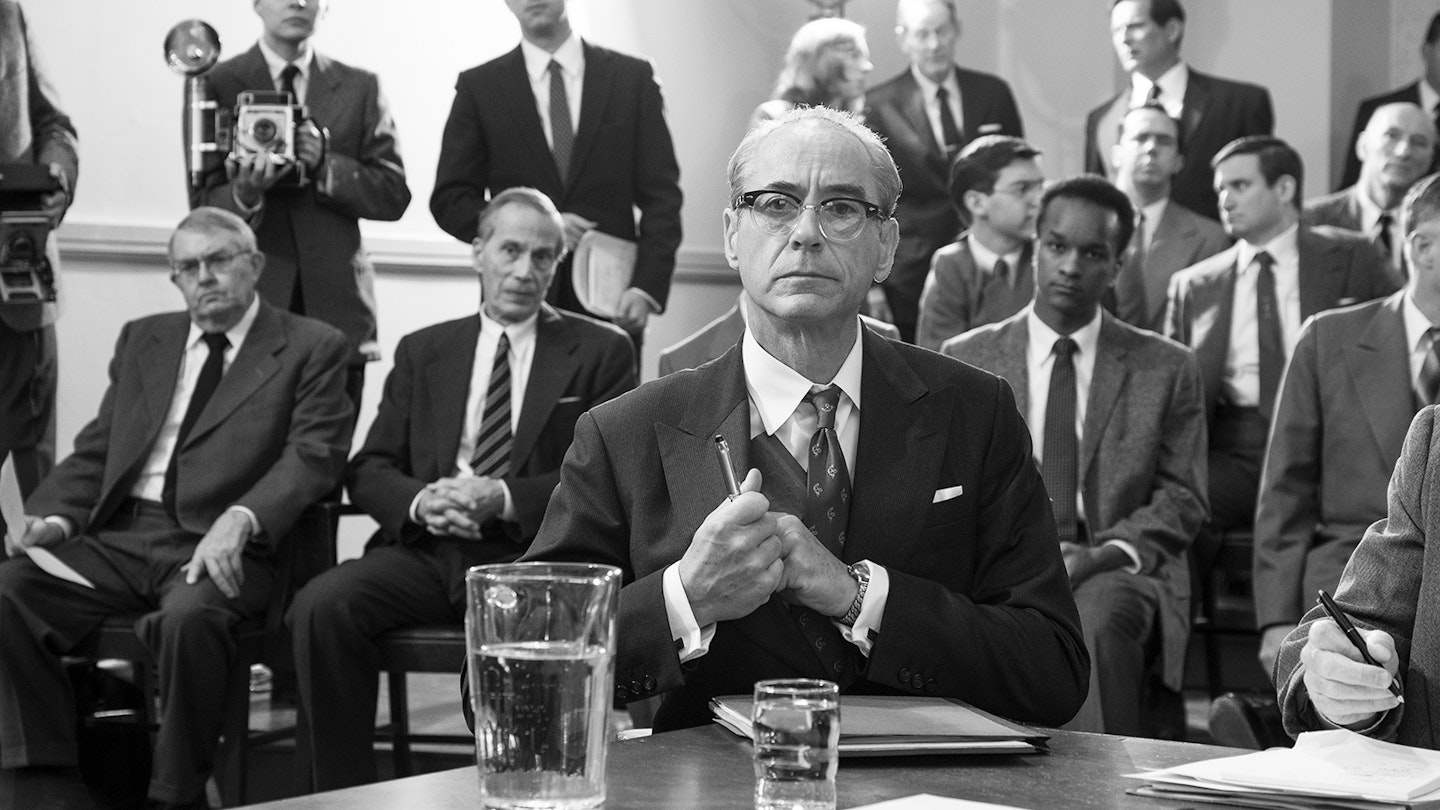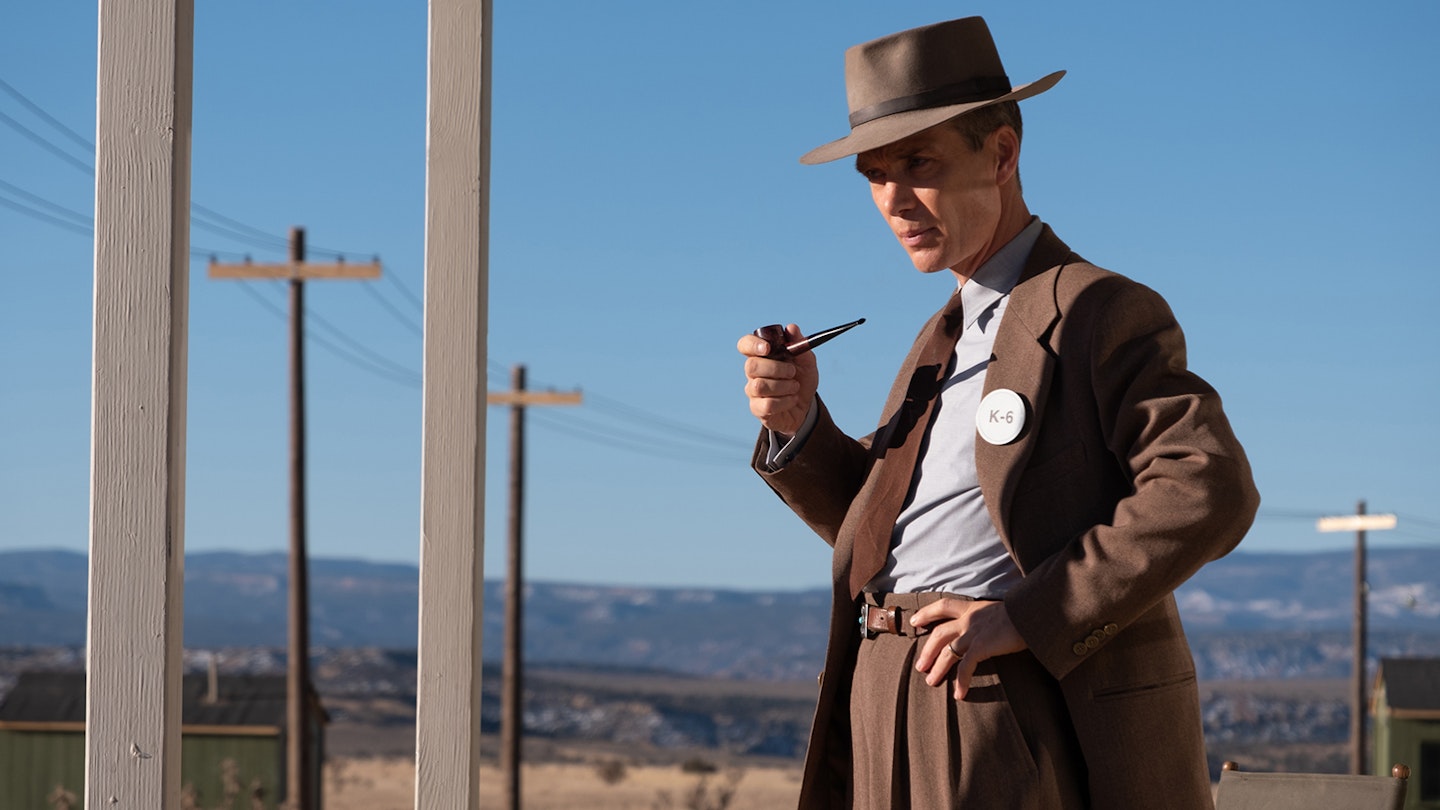Oppenheimer is not an easy movie. To say its subject matter and theme are inherently downbeat is something of an understatement. It flings you into a very specific, crowded world and refuses to hold your hand, with a notable absence of date- or location-providing subtitles. It is three hours long, densely packed with info-rich dialogue, and mostly plays out, to paraphrase one character, in “shabby little rooms far from the limelight”. Its story unfurls along two oscillating lines – one titled “Fission”, in vivid colour; the other titled “Fusion” in high-contrast black-and-white – and cuts between their beats and revelations like an anxious channel-hopper. It is, of course, a Christopher Nolan movie.
However, despite being deeply stamped with Nolan’s hallmarks (anti-chronological, shot with IMAX cameras, avoids CGI, stars Cillian Murphy), Oppenheimer feels like something new from the writer-director. While it has a logline-level similarity to Nolan’s favourite Spielberg film, Raiders Of The Lost Ark (a man in a hat is racing the Nazis for control of an existentially powerful weapon), its release — and impact — feel more like we’ve reached Nolan’s Schindler’s List moment: a step into deadly serious, portentously resonant, adult material. With one fundamental difference: this difficult historical figure is on a very different trajectory to Oskar Schindler. One might even say the exact opposite trajectory.

Oppenheimer is based on American Prometheus, Kai Bird and Martin J. Sherwin’s wide-spined biography of the theoretical physicist who “fathered” the atomic bomb. But it is not a biopic. No time is spent on J. Robert’s childhood, with his disturbingly troubled early academic life tackled only briefly. Instead, the film moves briskly from his establishment of quantum theory on US curricula to his recruitment as director of the Manhattan Project (by take-no-shit Lieutenant General Leslie Groves, played with avuncular appeal by Matt Damon).
At the film’s pulsing nucleus is Murphy as Oppenheimer, and he is compelling throughout.
Interestingly, Nolan does devote some time to Oppenheimer’s romantic entanglements, allowing Florence Pugh to elegantly dominate her few scenes as communist activist Jean Tatlock, the physicist’s first lover (which also involve a Nolan first: sex scenes with prolonged nudity). Meanwhile, Emily Blunt thankfully busts out of the supportive/suffering wife archetype as the alcoholic but sharp-witted Kitty Oppenheimer, who gives us one of the film’s most rousing scenes in an intense verbal duel with bullish lawyer Roger Robb (Jason Clarke).

Given the sheer extent of the dramatis personae, it’s no exaggeration to say that Oppenheimer features Nolan’s most impressive cast yet. Playing admirably against type, Robert Downey Jr. leads the “Fusion” strand as haughty US Atomic Energy Commissioner Lewis Strauss, whose attempt to join Eisenhower’s cabinet as Secretary of Commerce becomes intriguingly more relevant as the film progresses. Then we have a supporting cast like no other: Benny Safdie as Edward Teller (the inspiration for Dr Strangelove), Kenneth Branagh as Oppenheimer’s Danish mentor Niels Bohr, Josh Hartnett as his close colleague Ernest Lawrence — plus the likes of Olivia Thirlby, Rami Malek, Jack Quaid, Macon Blair, Casey Affleck, David Krumholtz and Alden Ehrenreich popping up in sometimes the smallest of roles. Not to mention Gary Oldman’s acidic cameo as President Truman, who famously dismissed Oppenheimer as “a cry-baby scientist”.
At the film’s pulsing nucleus is Murphy as Oppenheimer, and he is compelling throughout. Given the movie’s hefty import, you’d have expected him to infuse every ounce of his talent into this performance, and that is certainly evident from his every moment on screen — often with cinematographer Hoyte Van Hoytema’s IMAX lens focused squarely and unsparingly on his face, as he conjures the conflicting emotions that rage beneath Oppenheimer’s surface. This is, after all, a uniquely complex man: praised as a hero for ending the war, wracked with guilt over Hiroshima and Nagasaki, and perhaps desperate to cleanse his soul through martyrdom.
Nolan complements this exquisitely tuned performance by using his subject’s memories and visions as a kind of visual punctuation, from raindrops rippling ominously in puddles like bomb blasts, to a chilling, briefly glimpsed depiction of “atmospheric ignition”: a posited world-ending outcome of the first A-bomb test. The Trinity sequence itself, in which Nolan’s SFX team somehow create a CG-free approximation of a nuclear explosion, is truly shock-and-awesome, featuring what might just be cinema’s most intense countdown scene. But the film is never visually stronger than when it is inside Oppenheimer’s head, especially during its lengthy closing act, when apparitions of his creation’s life-snuffing effects bleed into his waking life with such nightmarish potency, they’ll be hard to shake for days.








